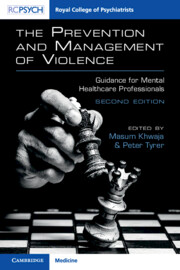Book contents
- The Prevention and Management of Violence
- The Prevention and Management of Violence
- Copyright page
- Dedication
- Contents
- Contributors
- Preface
- Abbreviations
- Section 1 General Aspects of Management
- Section 2 Medical and Psychological Intervention
- Section 3 Violence in Different Settings
- Section 4 Management in Other Groups
- Introduction to Section 4
- Chapter 13 Working With Violence in Children: A Developmental and Relational Perspective
- Chapter 14 Management of Violence in Older Adults
- Chapter 15 Management of Violence in People With Intellectual Disability
- Chapter 16 The Relationship Between Violence and Mental Health Inequality in the Black, Asian and Minority Ethnic Communities
- Section 5 Violence and Society
- Section 6 Engagement and Understanding
- Index
Introduction to Section 4
from Section 4 - Management in Other Groups
Published online by Cambridge University Press: 09 May 2023
- The Prevention and Management of Violence
- The Prevention and Management of Violence
- Copyright page
- Dedication
- Contents
- Contributors
- Preface
- Abbreviations
- Section 1 General Aspects of Management
- Section 2 Medical and Psychological Intervention
- Section 3 Violence in Different Settings
- Section 4 Management in Other Groups
- Introduction to Section 4
- Chapter 13 Working With Violence in Children: A Developmental and Relational Perspective
- Chapter 14 Management of Violence in Older Adults
- Chapter 15 Management of Violence in People With Intellectual Disability
- Chapter 16 The Relationship Between Violence and Mental Health Inequality in the Black, Asian and Minority Ethnic Communities
- Section 5 Violence and Society
- Section 6 Engagement and Understanding
- Index
Summary
Many groups are more vulnerable to violence than others, with children, some ethnic minorities and the elderly more at risk than others. In this section, these aspects of vulnerability are examined closely. Children exposed to violence are perhaps the group who suffer most, as the effects of abuse and harm can scar them for the rest of their lives. Their inability to resist makes the need for safeguarding paramount, but intervention often takes place late when the damage has been done. Older people and those with intellectual disability are similarly vulnerable and the chapters in this section offer sound advice on management. Black, Asian and other minority groups (BAME) deserve a separate chapter. They are both more vulnerable to violence and perceived as more likely to express violence, a perception that is often wrong and can have racist overtones. There is controversy over the causes of violence in this group, but the authors present a balanced view containing sound advice.
- Type
- Chapter
- Information
- The Prevention and Management of ViolenceGuidance for Mental Healthcare Professionals, pp. 201Publisher: Cambridge University PressPrint publication year: 2023

